Topic: (Nysed) Photosynthesis And Cellular Respiration Important Components Of The Carbon Cycle
(Nysed) Photosynthesis And Cellular Respiration Important Components Of The Carbon Cycle
Some sea slugs store chloroplasts obtained from algae they have ingested. The chloroplasts continue to carry out photosynthesis within the slugs. What advantage would this activity be to these sea slugs?
(1) The slugs with chloroplasts can synthesize some of their own food.
(2) The slugs with chloroplasts no longer need to carry out respiration.
(3) The chloroplasts provide the slugs with camouflage that protects them from UV radiation.
(4) The chloroplasts contain enzymes that allow the slugs to digest starch.
Which process uses energy to combine inorganic molecules to synthesize organic molecules?
(1) respiration
(2) digestion
(3) photosynthesis
(4) decomposition
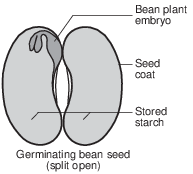
Plants are able to continue to grow and develop once the starch supply in the seed is gone, because they
(1) develop roots to absorb starch from the environment
(2) grow leaves, which use light energy for cell respiration
(3) have chloroplasts and use light energy to make more food
(4) produce more seeds, which contain additional food reserves
A cell in the leaf of a corn plant contains more chloroplasts than a cell in the stem of a corn plant. Based on this observation, it can be inferred that, when compared to the cell in the stem, the cell in the leaf
(1) synthesizes more sugar
(2) has a higher chromosome count
(3) produces fewer proteins
(4) uses less carbon dioxide
An investigation was conducted to compare two different types of plants. A student used a microscope to observe the cells in a cross section of a lilac leaf (diagram A) and a cell from the leaf of a freshwater plant (diagram B).

Which row in the chart below correctly identifies the structure labeled Y in both diagrams and the process it performs?

(1) 1
(2) 2
(3) 3
(4) 4
In the 1660s, Flemish physician Jan van Helmont grew a small willow tree in a pot of soil. He added only water to the pot. At the end of five years, he found that the tree had gained 75 kilograms, but there was very little change in the mass of the soil. Van Helmont concluded that the plant gained weight directly from the water. We now know that this conclusion is only partially correct because, in addition to water, photosynthesis also requires
(1) oxygen from the atmosphere
(2) carbon dioxide from the atmosphere
(3) proteins from animal prey
(4) carbohydrates from the soil
During the process of photosynthesis, energy from the Sun is converted into
(1) chemical energy in the bonds of inorganic molecules
(2) chemical energy in the bonds of organic molecules
(3) enzymes used to produce inorganic molecules
(4) enzymes used to produce organic molecules
The diagram below represents a cycling of materials.
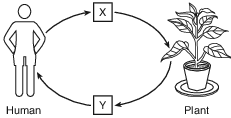
Which row in the chart below shows the substances represented by X and Y?
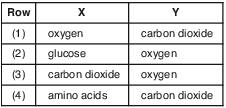
(1) 1
(2) 2
(3) 3
(4) 4
The diagram below represents a sequence of events that occurs in living things.
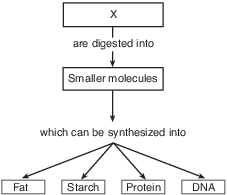
Letter X represents
(1) inorganic molecules
(2) organic molecules
(3) biological catalysts
(4) simple sugars
The cells of some organisms contain both chloroplasts and mitochondria. Which statement describes what would happen in these cells if they were moved from a light environment to a dark one?
(1) The amount of oxygen present would decrease and the amount of carbon dioxide would increase.
(2) The amount of glucose present would increase and ATP would no longer be available.
(3) The amount of carbon dioxide present would decrease and ATP would continue to be synthesized.
(4) The amount of oxygen present would increase and the amount of glucose available would decrease.
A student measured oxygen and carbon dioxide concentration levels in an aquatic ecosystem during a 24 hour period. The data are represented in the graph below.
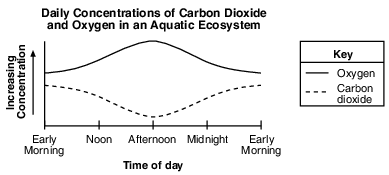
Identify two biological processes that are responsible for the production of varying amounts of carbon dioxide and oxygen within the aquatic ecosystem. [1]
Processes: ____________________________________ and ____________________________________
Allow 1 credit. Acceptable responses include, but are not limited to:
• — respiration and photosynthesis
• — photosynthesis and aerobic respiration
• — photolysis and respiration
The laboratory setup represented below was used to investigate the effect of light on aquatic plants. Equal amounts of a green water plant were placed in beakers with gas- collecting tubes. The beakers were placed in a temperature-controlled environment. The light source was placed at different distances from the beakers. After an hour, the amount of gas collected from the plants in each tube was measured and recorded in the data table.
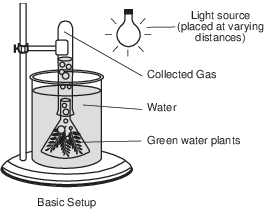
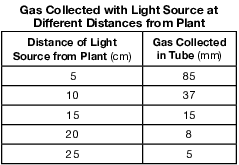
Directions: Using the information given, construct a line graph on the grid following the directions below.
Identify the gas being produced by the plants. [1]
Allow 1 credit for oxygen/O2.
A student conducts an experiment to determine how the amount of light affects the rate of oxygen production in a plant. The graph represents the rate of oxygen produced for one trial, X, in the experiment. By the end of the experiment, the plant had not reached maximum oxygen production.
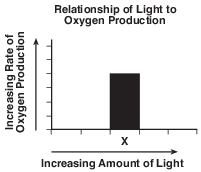
The diagram below represents a cell from the plant being used in the study. Draw an arrow to a cell structure directly responsible for oxygen production in this cell. The tip of the arrow must touch the cell structure. [1]
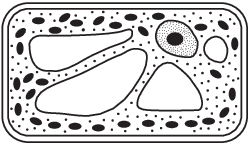
Allow 1 credit.
• Example of a 1-credit response:
• 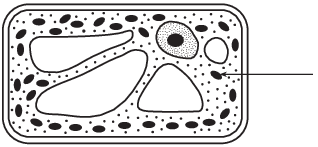
• Note: Allow credit for any line, with or without an arrowhead, that touches a chloroplast.
• If more than one arrow is drawn, all arrows must be correct to receive credit.
The photograph below is part of an advertisement used by a company selling solar panels. The company claims that their panels, like plants, provide clean, renewable energy. They also claim that using solar panels will have a positive effect on the biosphere by reducing global warming.
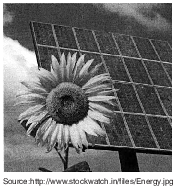
Explain why these claims are valid. In your answer, be sure to:
• explain why both plants and solar panels provide renewable energy, rather than nonrenewable energy [1]
• state how the widespread use of solar panels to generate electricity can help to reduce global warming [1]
• state how the energy-capturing process used by plants worldwide can help to reduce global warming [1]
The student’s response to the bulleted items in the question need not appear in the following order.
• 14 Allow 1 credit for explaining why both plants and solar panels provide renewable energy, rather than nonrenewable energy. Acceptable responses include, but are not limited to:
• — The Sun provides energy for both solar panels and plants that is continually being released.
• — The Sun is the energy source for both solar panels and plants and the energy is renewable.
• 15 Allow 1 credit for stating how the widespread use of solar panels to generate electricity can help to reduce global warming. Acceptable responses include, but are not limited to:
• — Fewer fossil fuels would be used, resulting in a decrease of global warming.
• — Using solar panels would decrease the amount of greenhouse gasses/carbon dioxide.
• 16 Allow 1 credit for stating how the energy-capturing process used by plants worldwide can help to reduce global warming. Acceptable responses include, but are not limited to:
• — Carbon dioxide increases global warming and photosynthesis takes carbon dioxide out of the air.
• — Plants remove carbon dioxide from the air.
• — Photosynthesis removes carbon dioxide from the air.
Oriental hornets are unique insects. A yellow pigment in the body of the insect converts solar energy to electrical energy. Plants also convert energy from the Sun.
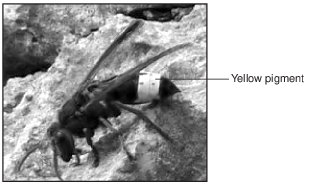
Identify the organelle present in plants where this conversion takes place. [1]
Allow 1 credit for chloroplast.
